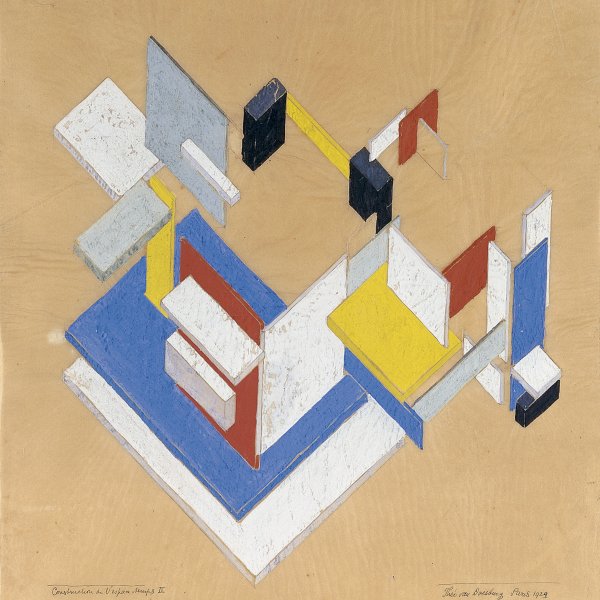Theo van Doesburg
Utrecht, 1883-Davos, 1931
Theo van Doesburg, whose real name was Emil Marie Küpper, was one of the key figures in the development of Dutch Neo-Plasticism in both painting and architecture.
A self-taught artist, during the early years he painted in a naturalist and Impressionist style and became influenced by the work of Wassily Kandinsky in 1914. During this period, Van Doesburg came into contact with various people connected with theosophy, such as his first wife and the painter Janus de Winter, who influenced his views on life and art and later left a powerful mark on Neo-Plasticism. He met Piet Mondrian in 1915, followed not long afterwards by Bart van der Leck and the architect J.J.P. Oud. Together with them and other artists he founded the review De Stijl. Van Doesburg acted as the magazine’s editor and published numerous articles under the pseudonyms J.K. Bonset and Aldo Camini. About 1916 he also began to collaborate with Oud in various architectural projects, initially by designing stained-glass windows, as a result of which his compositions became simpler in form and more geometrical and mathematical. Although his style evolved in accordance with Neo-Plasticist theories, which advocated the use of straight lines and primary colours, in 1925 Van Doesburg introduced the diagonal into his compositions, causing him to fall out permanently with Mondrian.
During the early 1920s Van Doesburg frequented members of the Dada movement, such as Tristan Tzara, Hans Arp and Kurt Schwitters, and published the review Mécano from 1922 to 1923. He also gave a course on De Stijl to students of the Bauhaus in 1922. His interest in architecture grew over the years and he collaborated in numerous designs, such as with the architects Cornelis van Esteren and Gerrit Rietveld from 1920 to 1924 on projects commissioned by Léonce Rosenberg. In 1925 he began to design a house-cum-studio at Meudon, which he did not live to see completed owing to his unexpected death from a heart attack in 1931.
A self-taught artist, during the early years he painted in a naturalist and Impressionist style and became influenced by the work of Wassily Kandinsky in 1914. During this period, Van Doesburg came into contact with various people connected with theosophy, such as his first wife and the painter Janus de Winter, who influenced his views on life and art and later left a powerful mark on Neo-Plasticism. He met Piet Mondrian in 1915, followed not long afterwards by Bart van der Leck and the architect J.J.P. Oud. Together with them and other artists he founded the review De Stijl. Van Doesburg acted as the magazine’s editor and published numerous articles under the pseudonyms J.K. Bonset and Aldo Camini. About 1916 he also began to collaborate with Oud in various architectural projects, initially by designing stained-glass windows, as a result of which his compositions became simpler in form and more geometrical and mathematical. Although his style evolved in accordance with Neo-Plasticist theories, which advocated the use of straight lines and primary colours, in 1925 Van Doesburg introduced the diagonal into his compositions, causing him to fall out permanently with Mondrian.
During the early 1920s Van Doesburg frequented members of the Dada movement, such as Tristan Tzara, Hans Arp and Kurt Schwitters, and published the review Mécano from 1922 to 1923. He also gave a course on De Stijl to students of the Bauhaus in 1922. His interest in architecture grew over the years and he collaborated in numerous designs, such as with the architects Cornelis van Esteren and Gerrit Rietveld from 1920 to 1924 on projects commissioned by Léonce Rosenberg. In 1925 he began to design a house-cum-studio at Meudon, which he did not live to see completed owing to his unexpected death from a heart attack in 1931.






